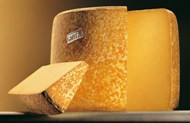
Made in the Haute-Auvergne, the ‘green region’ with its fertile pasture, the 2000 year old Cantal cheese is the oldest of all the cheeses.
In Auvergne, cheese and the land from which it comes are inextricably linked. The ‘burons’ are the visible traces of cheese production in Cantal. The earth and the vegetation of the mountains give their personality to the cheese. The geographical and volcanic geological character of Auvergne creates a large amount of precipitation, which gives the land its particular characteristics.
The richness in phosphoric acid, potassium and magnesium lead to the development of an abundant and original vegetation.
Liquorice, gentian, arnica and other flowers flourish in the grass when the cows arrive on the summer pasture. Here, 2000 years ago, was born Cantal cheese
The difficulties of the circulation linked to the relief and the winter climate led the ancesters of the master cheese makers to produce a very large cheese, the Cantal, in order to conserve food stocks.
There are a number of historic references which establish the long history. Pliny the Elder, in the 11th book of his ‘Historia Naturalis’ noted that the most valued cheese was that of the region of “Pays de Gabales and Gevaudan.”
Later, the Encyclopaedia of Alembert by Diderot, described the fabrication of Cantal and the equipment involved. The techniques evolved between 1890 and 1900. Emile Duclaux , follower of Pasteur who owned a property in Cantal, contributed massively to the development of the economy of Cantal, by creating a treaty in 1893 title “The principles of the dairy.” The first industrial milk dairies which could transform the milk of several herds appeared in 1910. The history of Cantal has marked the rhythm of life of the region for centuries and continues to do so today.
The rhythm depends on the seasons, of spring-summer, when the cattle and the people move to the pasture of the mountains of Cantal from May to September. The altitude is between 100 and 200 metres, and the people are cut off from the world for 5 months, working in the ‘burons’ (the dwellings) made from stone which serve as their home and their atelier for fabricating the cheese.
The team of ‘buronniers’ who worked the whole season in the ‘burons’ were charged with looking after the herds, milking them and then transforming it into cheese. They were very organised and had a hierarchy. At the head was the ‘Cantalès’ who milked the animals and made the cheese. Then there was the ‘vacher’ who looked after the herds, and finally, the ‘boutillier’ who washed the utensils and prepared the meals. The shepherd was a young apprentice
In September, was the ‘devalade.’ The cheeses were taken down to the valley and sent to Aurillac, the market town of the Haute Auvergne. There was a transaction between the owner and the seller to fix the price of the cheese.
This price depended on the quality of the cheeses, the fruit of the labour of the ‘buronniers’ which passed a test. Unhappily for those cheeses which did not make the mark, the farmer would lose out. For a long time, Cantal served as a currency between the regions of the south of France and the Haute-Auvergne, where wine was traded for cheese. Even today, these regions are linked to Cantal
Today, the producers are organised slightly differently, although some ‘burons’ do still exist. But the principle of the spring-summer season has not been abandoned. The herds still profit fully from the richness and diversity of the natural flora during this summer season.